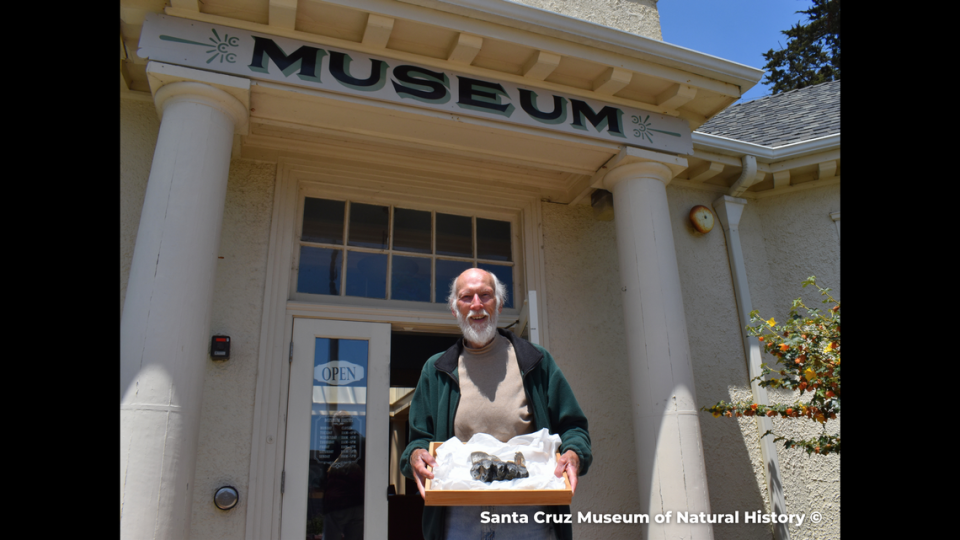Runner didn’t know he nabbed ‘invaluable’ find on CA beach — until turning on the news
As a runner trekked across a California beach, something caught his eye.
Jim Smith, who frequently runs in the Aptos area in Santa Cruz County, kept on going, though, Liz Broughton, the visitor experience manager at the Santa Cruz Museum of Natural History told McClatchy News.
But on his return, it captivated him once again, Broughton said.
Smith thought it “looked cool and interesting,” Broughton said, so he picked it up and brought it home.
Days later, he was shocked when an image of the very thing he brought home from the beach popped on screen while watching the news, according to Broughton.
Smith, Broughton said, had brought home an ancient artifact — a mastodon tooth.

The museum’s search for the tooth
Unbeknownst to Smith, Wayne Thompson, a paleontologist with the Santa Cruz Museum of Natural History, had been frantically searching for the tooth.
Just days before, Thompson told McClatchy News he came across a woman’s Facebook post, questioning what she may have found near Aptos Creek on Rio Del Mar Beach on Friday, May 26, after someone tagged him in the post.
“I took a look at it, and I knew it was a mastodon tooth,” Thompson said.
The out-of-town woman, however, did not pick up the tooth, and when Thompson went to search for it alongside her, it was gone, he said.
“With it being a holiday weekend on the beach, odds were never in our favor,” Broughton said. “But (Thompson) definitely put in the effort.”
Given its location, Thompson said he didn’t think the tooth would have been washed away with high tide. Rather, he suspected someone plucked it off the beach and took it home.
“I had very, very little hope that it would ever be found again, but I did have hope,” Thompson said.
So, he made posts on social media asking the person to come forward.
“We are currently ISO (in search of) anyone who might have recovered this tooth off the beach at the mouth of Aptos Creek at Rio del Mar,” Thompson wrote in an Instagram post. “It is an extremely important specimen: the worn molar of an adult extinct Pacific Mastodon, Mammut pacificus.”
The only other documented mastodon specimen from Santa Cruz County, a juvenile mastodon skull with two teeth, was “found in the exact same area” in the 1980s, Thompson said.
“Fossils in Santa Cruz County are fairly rare,” Broughton said. “That makes this find pretty invaluable to science.”

The odds of finding the tooth, which could help add to the picture of what ancient life may have looked like and how things have changed over time, were stacked against the museum, according to Broughton.
Then, as Smith tuned into a news segment about the tooth, the museum’s odds shifted.
’A happy ending’
Broughton said she got a phone call on the afternoon of Tuesday, May 30.
It was Smith, Broughton said. He wanted to donate the fossil.
“It was a happy ending,” Broughton said.

Shortly after the phone call, Smith brought the tooth, estimated to be about 10 inches long, to the museum.
“When it was turned in, I was absolutely amazed,” Thompson said.
Thompson said the museum plans to run tests to figure out the tooth’s age before putting it on display.
Right now, based on the carbon date from plant matter in the area where the other mastodon specimen was found, he said he believes it is about 5,000 years old.
Broughton said the tooth will add to the “knowledge of mastodons here in California.”
“There’s a finite number of those specimens in museum collections as well,” Broughton said. “So it’s just another specimen that can contribute to the full body of paleontological science, which is really exciting.”
Thompson said such finds are few and far between, with this particular specimen being “exceedingly rare,” as there is “only one other piece of evidence that we have that has surfaced in the last 40 years.”
“It’s a miracle it was returned,” he said.
9-year-old thought he found a ‘plastic container.’ It was actually a mammoth tooth
Dog finds 6 million-year-old mastodon bone at Hanford. Where to go see it
‘Once in a lifetime find,’ Boy finds massive, extinct shark tooth on SC vacation. Check it out

 Yahoo Sports
Yahoo Sports 